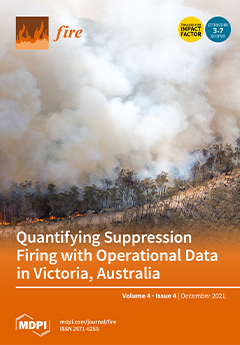This study examined the hydrological/meteorological controls on large wildfires > 10,000 acres (40.5 km
2) during 2017–2020 in Northern California at spatial and temporal scales of the target wildfires’ occurrence or growth. This study used the following simple indices for analysis: Moisture
[...] Read more.
This study examined the hydrological/meteorological controls on large wildfires > 10,000 acres (40.5 km
2) during 2017–2020 in Northern California at spatial and temporal scales of the target wildfires’ occurrence or growth. This study used the following simple indices for analysis: Moisture Deficit Index (MDI) computed by dividing vapor pressure deficit by soil moisture, MDIWIND computed by multiplying MDI by horizontal wind speed, and MDIGUST computed by multiplying MDI by wind gust speed. The ignition location MDIWIND and MDIGUST showed larger values on the ignition date in fire-years compared to non-fire-years for most of the target wildfires (95.8% and 91.7%, respectively). The peak timing of MDIGUST, which is to evaluate the integrated effect of dry atmosphere/soil and windy condition, coincided with the ignition date for August Complex Fire 2020, Ranch Fire 2018, Claremont-Bear Fire 2020, and Camp Fire 2018. We also found that August Complex Fire 2020, Claremont-Bear Fire 2020, and Camp Fire 2018 occurred in the areas where MDIGUST became spatially and temporally high. Further, strong relationships were found between burned area sizes of the target wildfires and MDI (R = 0.62,
p = 0.002), MDIWIND (R = 0.72,
p < 0.001), and MDIGUST (R = 0.68,
p < 0.001). Overall, the findings in this study implied the strong effect of dry atmosphere/soil and windy conditions on recent large wildfire activities in Northern California. The findings could contribute to a more temporally and spatially detailed forecast of wildfire risks or a better understanding of wildfires’ occurrence and growth mechanisms.
Full article





